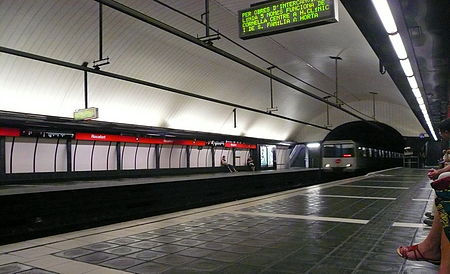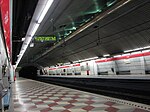Rocafort station (Barcelona)
Barcelona Metro line 1 stationsBarcelona Metro stubsCatalan railway station stubsRailway stations located underground in SpainRailway stations opened in 1926

Rocafort is a Barcelona Metro station, named after the Carrer de Rocafort, in the Eixample district of the city of Barcelona. The station is served by line L1.The station is located under the Gran Via de les Corts Catalanes between the Carrer de Rocafort and the Carrer de Calàbria. The station can be accessed from entrances on the Gran Via, the Carrer de Rocafort and the Carrer de Calàbria. It has twin tracks, flanked by two 88-metre (289 ft) long side platforms.Rocafort is on the original section of line L1 (then the Ferrocarril Metropolitano Transversal de Barcelona) between Catalunya and Bordeta stations, which was opened in 1926.
Excerpt from the Wikipedia article Rocafort station (Barcelona) (License: CC BY-SA 3.0, Authors, Images).Rocafort station (Barcelona)
Gran Via de les Corts Catalanes, Barcelona
Geographical coordinates (GPS) Address Nearby Places Show on map
Geographical coordinates (GPS)
| Latitude | Longitude |
|---|---|
| N 41.378888888889 ° | E 2.1544444444444 ° |
Address
Gran Via de les Corts Catalanes 446
08001 Barcelona
Catalonia, Spain
Open on Google Maps










